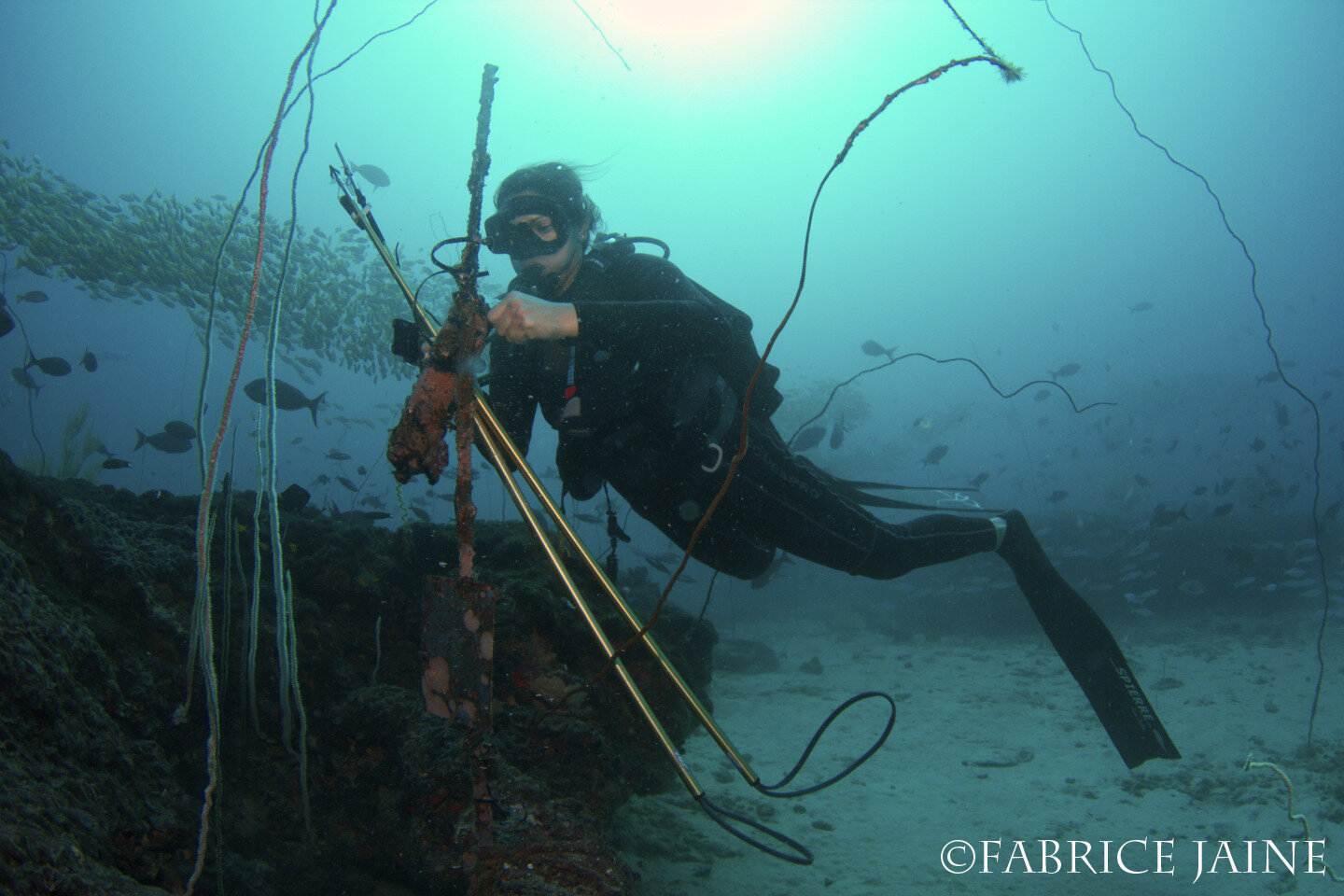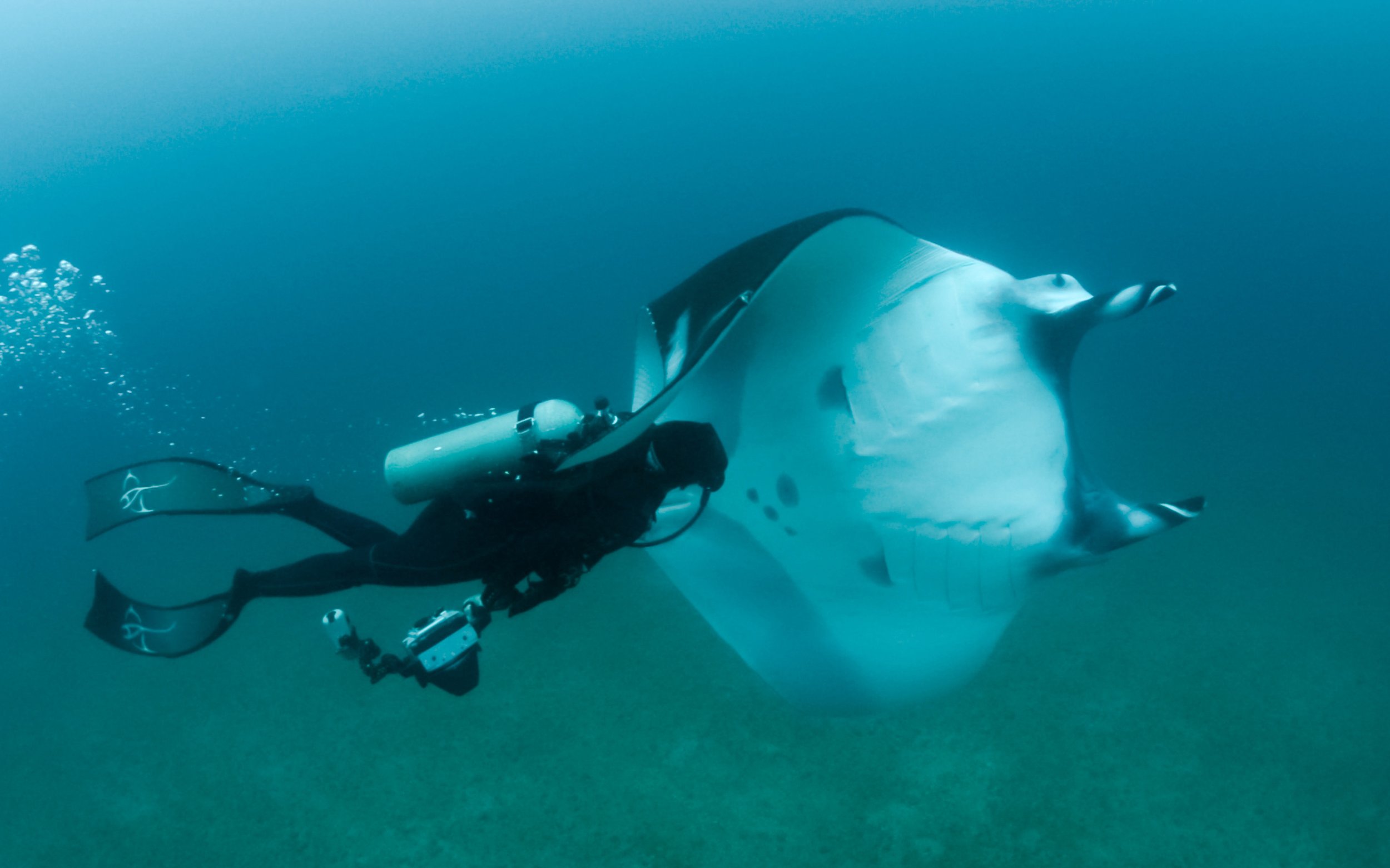Underwater ‘listening stations’ track reef manta rays in Mozambique
Underwater ‘listening stations’ track reef manta rays in Mozambique
Understanding the movement patterns of manta rays that can travel thousands of kilometers, dive hundreds of meters deep and don’t need to come to the surface to breathe is no simple task.
Where do they go and when? How far do they navigate? And where do they spend most of their time? The solution to these questions lies in telemetry, more commonly known as “tagging”, where data is collected remotely from acoustic (which transmit an underwater sound signal) or satellite (which send information via satellites) transmitters attached to the animals.
Acoustic telemetry reveals critical habitat and movements of manta rays in Mozambique. Infographic: Elitza Germanov and Steph Venables
Collecting this data is a vital step in protecting reef manta rays, which are listed as ‘vulnerable’ and decreasing on the IUCN Red List of Threatened Species, as it can be used to develop and shape effective protection strategies in the areas where they need it most.
In a new study, published today in the journal Marine Ecology Progress Series, researchers from the Marine Megafauna Foundation (MMF), University of Western Australia and Utrecht University used acoustic telemetry to identify critical habitat areas and understand movement patterns of reef manta rays in the waters off Mozambique’s Inhambane Province.
A tagged manta ray swims past a ‘listening station’ in Mozambique’s waters. Image credit: Andrea Marshall
MMF scientists have been studying the manta rays in this region for over a decade using a range of research techniques including photo identification and aerial surveys. “Long-term photo ID studies have provided excellent preliminary data about the manta rays that visit this coastline, however acoustic telemetry allowed us to continuously monitor multiple individuals for periods of up to 2 years, providing us with more detailed movement data,” explained lead author Stephanie Venables, a researcher with the Marine Megafauna Foundation and PhD candidate at the University of Western Australia.
“Understanding how manta rays use these waters, how far they move and where they spend the majority of their time is vital information for designing effective protection measures,” she added.
The researchers assembled an array of underwater acoustic receivers or ‘listening stations’ which were placed at 14 sites over a 250 km stretch of coastline from the Bazaruto Archipelago through to Tofo Beach and Závora in southern Mozambique. These sites ranged from cleaning stations, where mantas were known to regularly visit, to feeding sites and reefs located along potential movement pathways. They tracked 42 reef manta rays using acoustic transmitters between 2010 and 2014. These transmitters, or ‘tags’, each emit a unique acoustic signature, which are detected by the listening stations whenever a tagged animal comes within a few hundred meters. The receivers store the information and researchers collect the receivers every few months to download the data and see which of the tagged manta rays came past.
Dr. Andrea Marshall retrieves a listening station from one of the study sites to download the stored data. Image credit: Fabrice Jaine
The marine biologists monitored a number of reefs that are known manta ray ‘cleaning stations’, where certain species of reef fish ‘clean’ manta rays by removing parasites, as well as any dead or infected tissue. Cleaning station sites proved to be important habitat for the tagged mantas, with 95% of detections recorded at these reefs.
The study also found manta rays have somewhat of a routine, paying visits to cleaning stations more frequently during the day. Such patterns have previously been described at manta ray aggregation sites in Australia, Indonesia and the Seychelles. Manta rays in Mozambique visited cleaning stations for 26 minutes on average. However, a quarter of the tagged individuals stayed for over 3 hours at these reefs, with the longest consecutive visit spanning over 8 hours. They also returned to favored sites on multiple occasions, in some cases after up to 7 months, a behavior known as ‘site affinity’.
‘Cleaning stations’ proved to be an important habitat for the tagged mantas – 95% of detections were recorded at cleaning station reefs. Image credit: Daan van Duinkerken
But where did the manta rays go at night? Manta rays were almost entirely absent from monitored reefs after dark, with the exception of one site where they have been observed feeding on zooplankton. “It’s likely that mantas are moving into deeper, offshore waters outside of the detection range of the acoustic array at night. We expect that these waters are feeding grounds for the manta rays,” explained Daan van Duinkerken, MMF researcher and co-author on the study.
In a 2013 study, MMF researchers documented an 88% decline in reef manta ray sightings over a single decade in the Inhambane Province – a worrying finding that highlights the need to minimize negative impacts on this population by putting effective conservation measures into effect in habitats where these vulnerable animals aggregate.
“Manta rays face a number of human-induced threats throughout their range including targeted fishing (for their gill plates), incidental capture (by-catch) and entanglement in fishing gear,” said Venables. In Mozambique, gill nets — large nets that stretch from the seabed to the surface and can be hundreds of meters in length — are a major threat to many marine species including sharks, rays and sea turtles, which become easily entangled in the mesh.
Cownose rays entangled in a gill net – the indiscriminate nature of gill nets poses a major threat to many marine species. Image credit: Daan van Duinkerken
The researchers used the tagging data to identify areas that are most frequently used and to estimate and map the extent of their core habitat and regional range. This information is crucial for informing the design of spatial management such as marine protected areas (MPAs). When comparing this to current protected areas in the province, the team found that three quarters of manta ray habitat remain unprotected.
“Offering protection to a mobile species across its entire range is both logistically and financially demanding. Protecting core habitat areas, where the animals spend most of their time, is a good starting point. These typically include feeding and breeding grounds, and in the case of manta rays, cleaning stations,” said Dr Andrea Marshall, co-founder and principal scientist of MMF’s global manta ray program.
The study found manta rays to move widely between these high-use sites and the scientists believe that restricting the use of indiscriminate fishing gear, like gill nets, would lessen the risk to manta rays and other species being trapped as they move between the sites. “We hope this knowledge can be used to develop more effective protection for manta rays in Mozambique, in the areas where they need it most,” Dr Marshall concluded.
MMF’s field research in Mozambique is supported by Peri-Peri Divers, Casa Barry Lodge, Tofo Scuba, Pestana Bazaruto, Big Blue, Zavora Lodge, J. Wright and Y. Tibirica, Pomene Lodge, Paindane Dive and D. Steuber.
The study entitled “Habitat use and movement patterns of reef manta rays Mobula alfredi in southern Mozambique” was published in the journal Marine Ecology Progress Series on 23 January 2020 and is available here: https://doi.org/10.3354/meps13178















